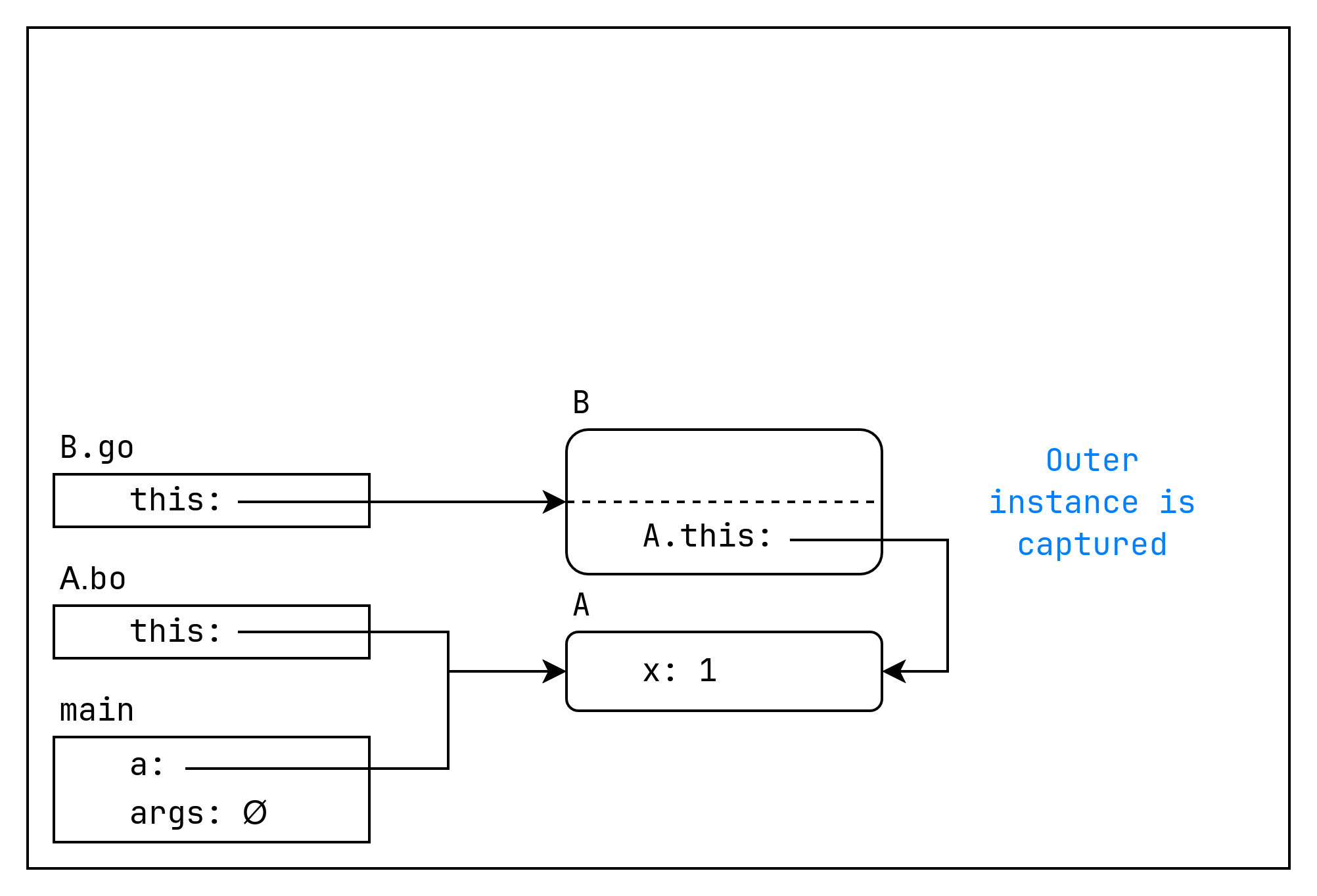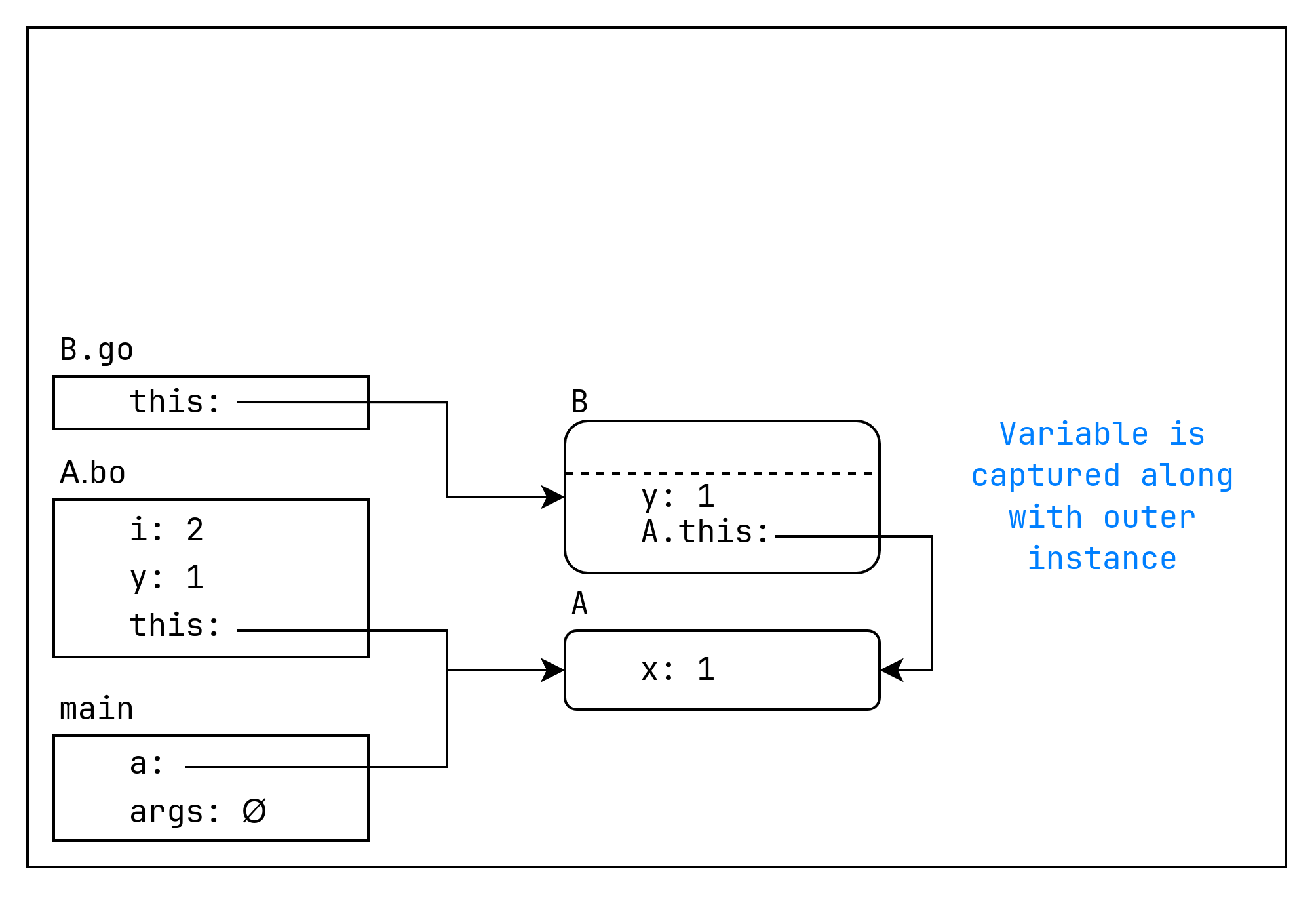Summary
Inner class
- requires an instance of the outer class
java
class A {
private int x;
static int y;
class B {
private int x;
void foo() {
x = 1; // instance field from B
this.x = 1;
y = 1; // static field from A
A.y = 1;
A.this.x = 1; // instance field from A
}
}
}
A a = new A();
A.B b = a.new B();
Static nested class
- does not require an instance
java
class A {
private int x;
static int y;
static class C {
void bar() {
x = 1; // cannot access instance field from A
y = 1; // can access static field from A
}
}
}
A.C c = new A.C();
Local class
- class declared within a method
java
class A {
int x = 1;
void f() {
int y = 1;
class B {
void g() {
x = y; // accessing x and y is OK.
}
}
new B().g();
}
}
// in B...
// A.this
Anonymous class
- single use local class
- either extends from a class or implements an interface
java
new X(arguments) { body }
// X is a class that the anonymous class extends, or the interface it implements
// arguments are supplied to the constructor, like using super()
// override methods or implement them in the body, no constructor
Concept
Fully qualified name
java
class A {
int x = 0;
int f() {
int x = 3;
return x; // x is potentially ambiguous, use this.x to refer to outer x
}
}
Accessing enclosing class (Inner classes)
- inner class has a reference to the outer class instance
Variable capture (Local classes)
- only capture variables that are used in the local class
- only allowed for variables that are final or effectively final, ie. cannot be reassigned after initialization
- get around this using mutable reference types, sus though
java
interface C {
void g();
}
class A {
int x = 1;
C f() {
int y = 1; // alone, this would be effectively final
y = 2; // not effectively final, no reassignment even if before the local class is declared
class B implements C {
void g() {
x = y; // accessing x and y is OK.
}
}
y = 2; // not effectively final
B b = new B();
return b;
}
}
Application
Hiding inner classes
java
class A {
private class B {
public void buz() {
}
}
B foo() {
return new B();
}
}
A a = new A();
a.foo(); // works, return an instance of A.B is OK
A.B b = a.foo(); // error, type A.B is private
a.foo().buz(); // error, A.B::buz is defined in a private nested class
Comparator
java
Comparator<String> cmp = new Comparator<String>() { // implements comparator
public int compare(String s1, String s2) {
return s1.length() - s2.length();
}
};
names.sort(cmp);
Inner class captures outer instance
java
class A {
int x = 1;
class B {
void go() { System.out.println(x); } // A.this.x works also
}
void bo() {
new B().go();
}
}
A a = new A();
a.bo();

Local class only captures variables that are used internally
java
class A {
int x = 1;
void bo() {
int y = 1;
int i = 2;
class B {
void go() {
System.out.println(x); // A.this.x works also
System.out.println(y);
}
}
new B().go();
}
}
A a = new A();
a.bo();

this way
xmust be effectively final for use withinBbutican still be modified
Scope and effectively final
java
class E {
int w;
void doTask() {
int x;
class F {
int y;
F() {
w = 1; // comes from E.this.w
x = 1; // error: not effectively final
y = 1; // class field
z = 1; // error: scope
}
}
F f = new F();
}
class G {
int z;
}
}
Extra
Check for correctness
https://thisisadi.yoga/Programming/Tools/StackHeap/ - A good stack and heap diagram visualizer
It uses a slightly different naming convention - the
$follow java’s internal naming convention for nested classes